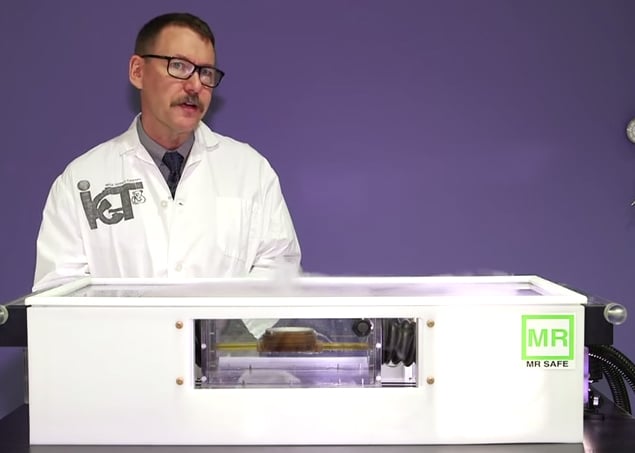
August 15, 2014 — A team of doctors at The Hospital for Sick Children (SickKids) in Ontario, Canada, have, for the first time in North America, successfully destroyed a bone tumor using high-intensity ultrasound guided by magnetic resonance imaging (MRI), rather than traditional surgery.
“With high-intensity focused ultrasound, we are moving from minimally invasive to non-invasive therapy, significantly reducing risk to the patient and fast-tracking recovery,” says SickKids interventional radiologist Dr. Michael Temple, associate professor of Medical Imaging at the University of Toronto and leader of the team that performed the surgery. “The osteoid osteoma tumor was chosen as our pilot study because the lesion is easily accessible and, while the procedure is sophisticated, it is relatively straightforward. The success of this first case is great news for Jack [Campanile, the patient], and exciting for our team as we look at developing more complex incisionless treatments in the future.”
This breakthrough is the latest from SickKids’ Centre for Image-Guided Innovation and Therapeutic Intervention (CIGITI), a research program that brings together surgeons, radiologists, software developers and engineers to develop innovative technologies in robotic and minimally-invasive surgery. The CIGITI bone tumor treatment project is funded by the Canada Foundation for Innovation, the Ontario Research Fund, FedDev Ontario, the Canadian Institutes of Health Research, the Natural Sciences and Engineering Research Council of Canada and the Garron Family Cancer Centre at SickKids. The clinical pilot study is funded by grants from the Focused Ultrasound Foundation’s Clinical Indication Track and the Mary Jo Haddad Innovation Fund from SickKids Foundation.
The osteiod osteoma had caused the patient, 16-year-old Jack Campanile, excruciating pain for a year before the procedure. By the time he went to bed that night, the athletic teen experienced complete pain relief.
In previous decades, osteoid osteoma was treated with orthopaedic surgery that involved scraping the tumor from the bone or removing the affected part of the bone. Since the mid-1990s, minimally invasive treatments have proven effective — using radio frequency or laser energy is delivered through a needle placed in the tumor using computerized tomography (CT) guidance.
However, these procedures still carry risks, including radiation exposure, infection, burning of the surrounding tissue and bone fractures resulting from the hole that remains following treatment of the tumor.
High-intensity focused ultrasound therapy uses sound waves, guided by MRI, to heat an area the size of a grain of rice to destroy the tumor. The treatment is completely non-invasive, so the skin and surrounding bone remain intact, greatly reducing the risk of complications such as infections. The use of MRI rather than CT scan to guide the sound waves means the patient avoids exposure to radiation. The risk of bone fracture is also likely lower than in other treatments, and recovery is quick. An added benefit is rapid pain relief.
SickKids staff performed the procedure using a specialized MRI table at Sunnybrook Health Sciences Centre, with support from Sunnybrook’s MRI and radiation oncology staff. While the surgery itself took 30 minutes, it required about three hours of preparation, including general anesthesia and precise placement of the patient on a table equipped with a built-in, high-intensity focused ultrasound transducer. The team used the MRI to determine the exact location of the tumor and to help target the ultrasound waves to burn the whole tumor one focal spot at a time at a high energy. The MRI also enabled them to ensure that there was no unexpected increase in heat in surrounding tissues. Accurate positioning and monitoring are critical, as the ultrasound waves could damage surrounding tissues, nerves or skin.
A few hours after the procedure, Jack was discharged home, where his recovery has been smooth and quick, with no complications to date. After dealing with a few hours of severe pain following the procedure, he was suddenly pain free. That night, he had uninterrupted sleep for the first time in months. Two days following the procedure, Jack was able to resume most daily activities, including a day trip to Niagara Falls on day four.
Before the surgery, Jack’s pain was so debilitating that he needed to take pain medication up to four times daily. “If I didn’t treat the pain attack early enough, it would be so strong that it felt like someone was trying to bend my femur into the shape of a hockey stick,” says the 16-year-old hockey player, snowboarder and wakeboarder, who took his last painkiller following the procedure.
The idea of being the first to undergo this new treatment was intriguing, Jack explains. “I wanted to see what it would be like. If it did work, it would be a whole new world for medical procedures and treating osteoid osteoma.”
This breakthrough is the latest from SickKids’ Centre for Image-Guided Innovation and Therapeutic Intervention (CIGITI), a research program that brings together surgeons, radiologists, software developers and engineers to develop innovative technologies in robotic and minimally-invasive surgery.
“This achievement is both a technical and organizational feat and required several years of collaborative work and fine tuning. We see huge potential in using this technology to develop new, non-invasive therapies in a number of other medical and surgical areas, including the treatment of soft-tissue tumors, paediatric stroke and epilepsy,” said Dr. James Drake, lead of CIGITI; head of the Division of Neurosurgery and Senior Associate Scientist at SickKids; and professor of surgery at University of Toronto.
High-intensity focused ultrasound therapy is available in pediatric and adult centers in Europe. The procedure was first performed on patients with osteoid osteoma in Italy in 2010 and is currently used in North America to treat uterine fibroids and bone metastases in adult patients. Osteoid osteoma occurs most commonly in males 10 to 35 years of age. The condition has been reported in patients as young as seven months. Despite its small size — about 1 cm — the tumor is known to cause extreme pain. SickKids sees as many as 18 patients per year with this condition.
This breakthrough was made possible with the efforts of a multidisciplinary team at SickKids: Drs. Adam Waspe, Joao Amaral, Thomas Looi, Maria Lamberti-Pasculli, Joost de Ruiter, Fiona Campbell, Sevan Hopyan and Jane Church. From Sunnybrook: Greg Czarnota, Yuexi Huang, Ruby Endre, Claire McCann, Young Lee and Kullervo Hynynen.
For more information: www.sickkids.ca


 December 15, 2025
December 15, 2025 









